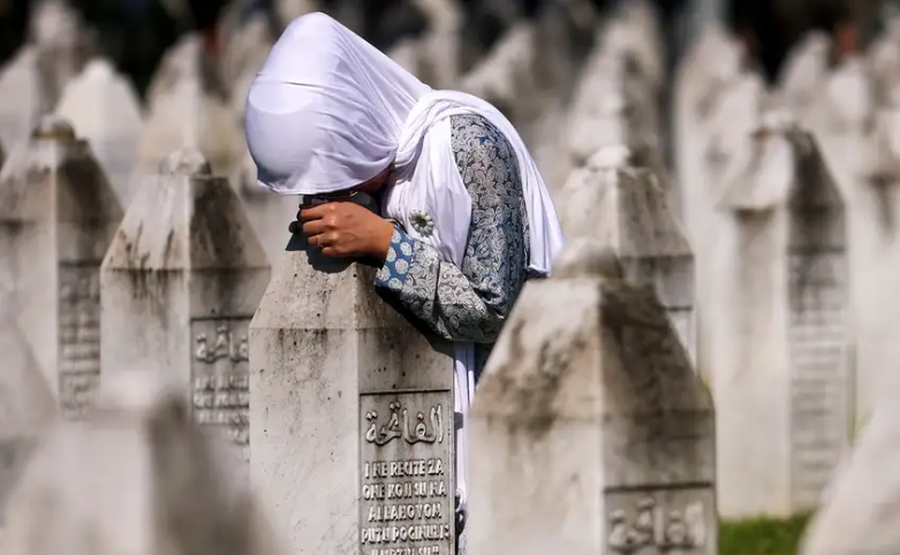
Recent school textbooks in Serbia have added information about the wars of the 1990s. But it has been "used in the most wrong way possible," experts say. DW investigated what is being taught about Srebrenica.
More than 8,000 Bosniak men and boys were killed by the Army of Republika Srpska in Srebrenica, Bosnia and Herzegovina, in July 1995, according to official figures from the International Criminal Tribunal for the former Yugoslavia, better known as the Hague Tribunal.
Serbian authorities strongly oppose the definition of this crime as genocide and categorically deny it. Deutsche Welle investigated how history is interpreted in such a political atmosphere and whether and how Srebrenica is presented in history textbooks in Serbia.
What is written in the history books?
Unlike in previous years, when Srebrenica was mentioned "more often in the lists of crimes by various parties, almost without explanation," the situation is somewhat different today, historian and university professor Dubravka Stojanović explains to DW.
She says that in the last generation of published textbooks, the space devoted to the wars of the 1990s has increased, but that it has been "used in the most wrong way possible."
Stojanovic points out that, in addition to a textbook that cites the decisions of the courts in The Hague without comment, in other textbooks the authors have entered into a debate with the courts, which were established by the United Nations (UN). "The main goal of these arguments is to deny genocide or completely relativize what happened in Srebrenica. This is done by stating in a textbook that it was captured men who were shot, but also that a number of them died in the fighting, which loses the character of a massive and systematic crime committed with the aim of killing all male inhabitants," explains the professor at the Faculty of Philosophy in Belgrade.
"In another book," she further explains, "it says that the transportation of women and children was facilitated, which almost seems like a humanitarian act, not an act of ethnic cleansing."
She also points out that the crime in that book is justified by the fact that Srebrenica was not a UN demilitarized zone, as planned, "as if that could justify the killing of so many inhabitants."
She notes that one of the textbooks also enters into a debate about the number of victims, stating that "historians disagree with the numbers, that they are exaggerated or even that the court has not determined them accurately, and does not say that mass graves are still found."
"It also enters into a debate with the court's decisions and states that there are still debates about the classification of this crime. It is said that 'most Serbian legal experts think that the Hague Tribunal is biased,' which directly delegitimizes and underestimates it."
"This shows the state's policy of educating about war crimes."
Genocide denial
Other researchers have reached similar conclusions by analyzing available history textbooks. An analysis by the Youth Initiative for Human Rights (YIHR) of how history textbooks in Serbia describe the wars of the 1990s shows that 15 out of 16 analyzed textbooks for primary and secondary schools mention Srebrenica, "but in such a way as to create a context in which genocide is justified," Marko Milosavljevic of YIHR explains to DW.
He considers this a form of "institutional denial," which is consistent with their findings on genocide denial. This denial has also been made by government representatives at least 40 times over the past year.
"This shows the state's policy on education about war and war crimes, where the constant designation of victims by numbers and identity denigrates them."
Historian Stojanović agrees with these claims. She says that this historical interpretation in Serbia "directly denies the genocidal nature of this crime, as well as the decisions of the only relevant international courts, which further creates the impression that the international community is in some kind of conspiracy against the Serbs and that the Serbs are being accused without basis."
"This reinforces the impression of vulnerability, but also creates a psychological basis for new aggressive behaviors," she says.
Disputes within the profession
In addition to textbooks that present Srebrenica in different ways, disagreements about whether and how such events should be taught to children also exist among history teachers.
In the opinion of some of them, not enough time has passed for knowledge to be consolidated in the professional community, and the data from the decisions are not sufficient to consider something as scientific truth.
"Methodologically, it's not history, not enough time has passed and we don't have archives. It's called a retelling of recent events, for which no one is an expert, because it hasn't been proven. You have witness statements, decisions, memories of various participants in those events, but that's not enough for science. It would be foolish to teach something to students, and I don't know more about this subject than they do," Marko Pishtalo, a history professor at Belgrade's Fifth Gymnasium, told DW. "I refer to historical sources and literature for everything I teach them during the year, and here I don't have any valid sources," he says.
Who writes history?
Historian Pishtalo is angry with his colleagues in Serbia, who agree to write textbooks about "yesterday's things", because in a situation where an event has not even passed fifty years, the writing "comes out biased, partisan and politically controlled".
"In a word," says Pishtalo, "there is less science here. Textbooks are written, but they are not processed as science and history require. On the contrary, they lean to one side. The purpose of the lessons is to show what history is, how much time should pass and what is the basis for writing, otherwise everything really comes down to the cliché that history is written by the winners."
And while we wait for publishers to agree on certain pieces of material, students are leaving school with very little knowledge about the wars of the 1990s.
YIHR's research on young people's attitudes on these topics shows that the respondents' knowledge, according to their personal assessment, is "very modest" and that they have more knowledge about events in which Serbs were victims.
Of the 910 respondents, the largest number ranked Operations "Storm" and "Flash" (in Croatia) as the greatest crime committed on the territory of the former Yugoslavia. On the other hand, 38 percent ranked the killing of Bosniaks in Srebrenica as genocide, while 34 percent did not know how to respond.
What do young people think?
Marko Milosavljević from YIHR says that 30 years after such an important event, from a moral point of view, it is "too late to discuss it." He reminds us that this year the first historiographical study on Srebrenica was published in Serbia, written by Dragan Popović, which he considers another confirmation of his position.
"This book took 30 years, but it is not only based on the decisions of the Hague Tribunal. It also refers to publications that analyze not only the genocide against Bosniaks in Srebrenica, but also the war crimes of the Bosnian Army commanded by Naser Orić in the middle Podrinje region," Milosavljevic explains to DW.
The state is responsible for such inconsistent content in school textbooks, according to historian Stojanović. "The non-governmental sector has done everything it could. It is necessary for the state to accept the decisions of international courts and educate society about the evil nature of nationalism. But we cannot expect this because we have the same authorities that we had in the 1990s," Stojanović concluded for DW. (A2 Televizion)











